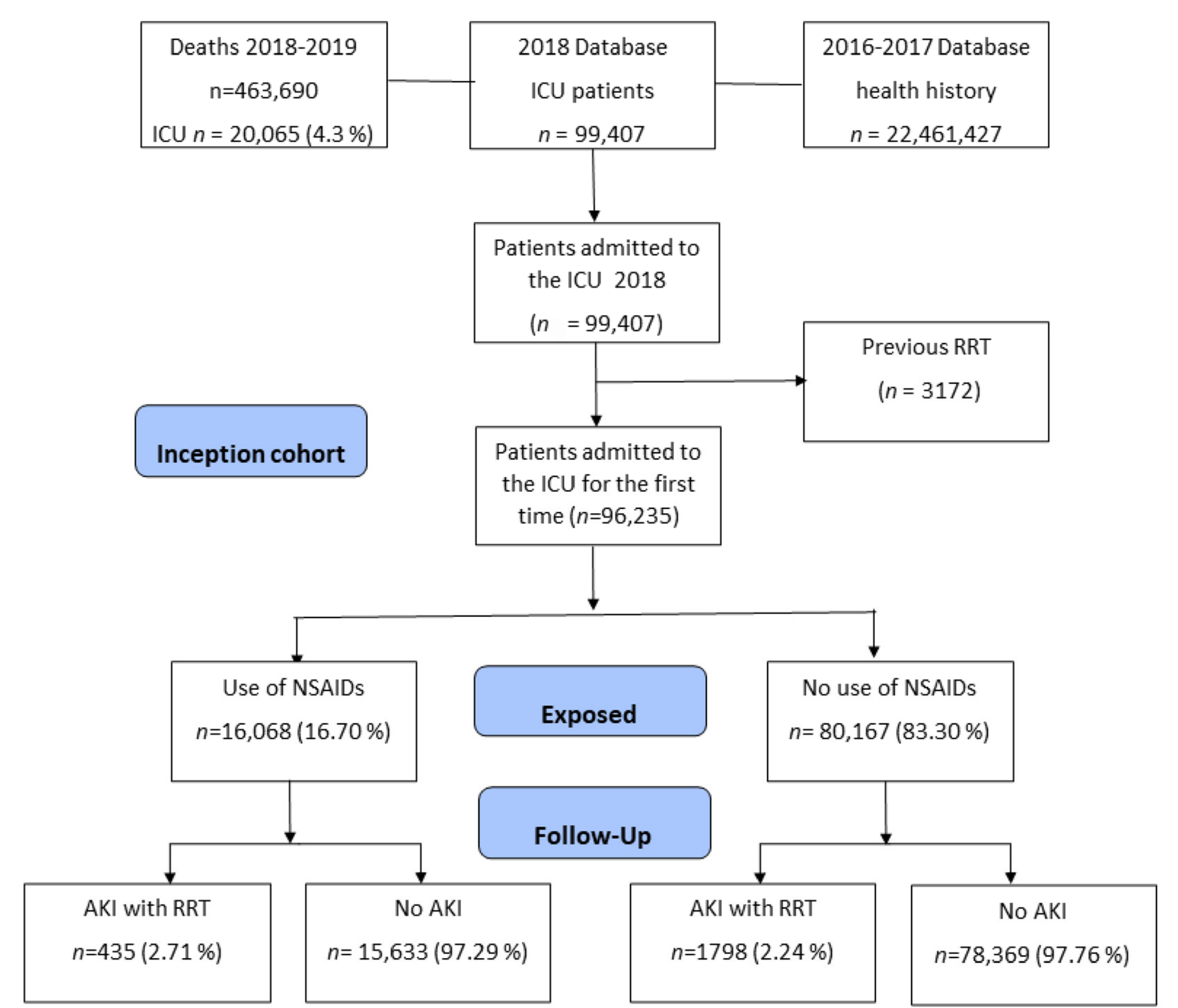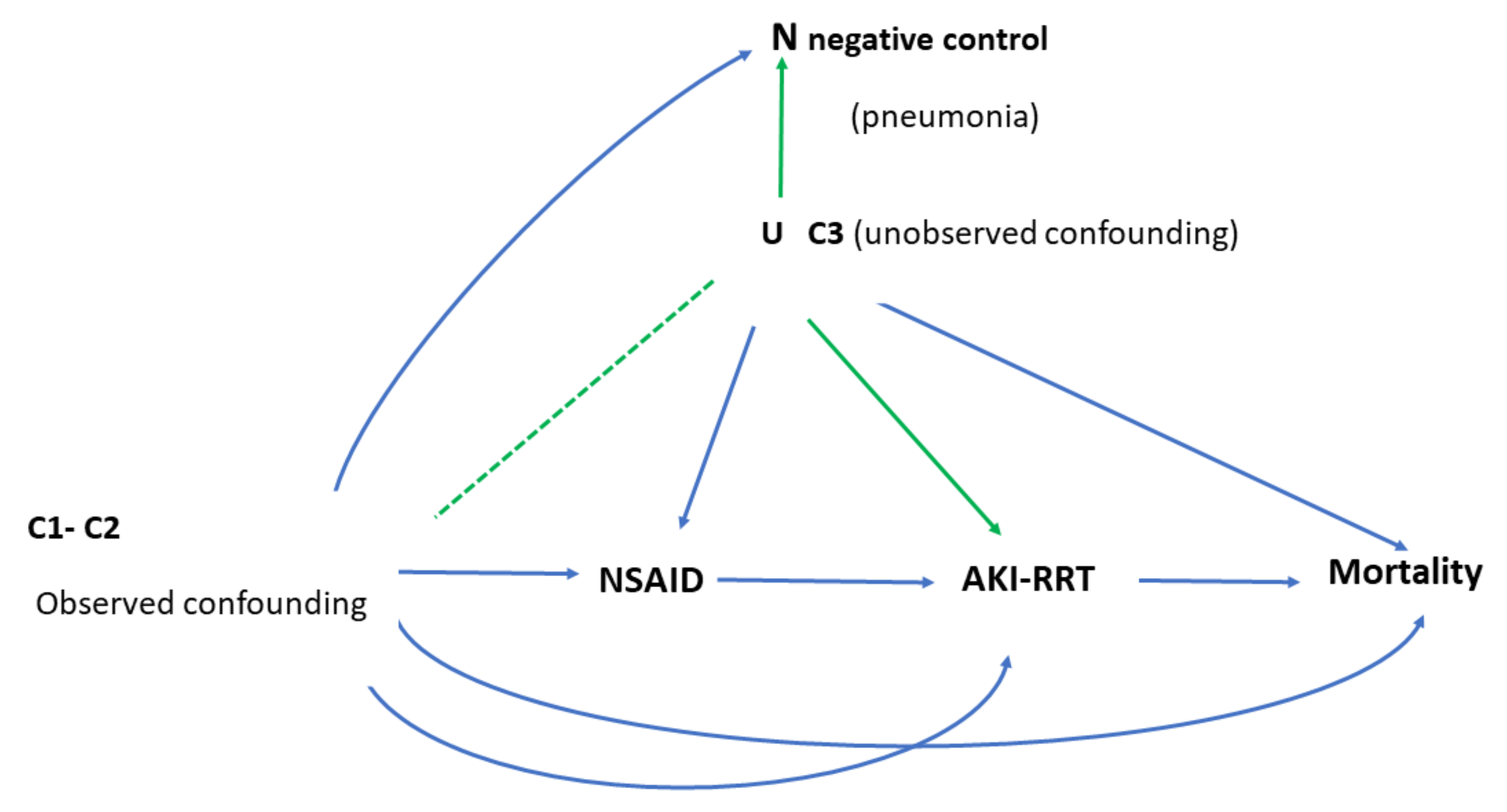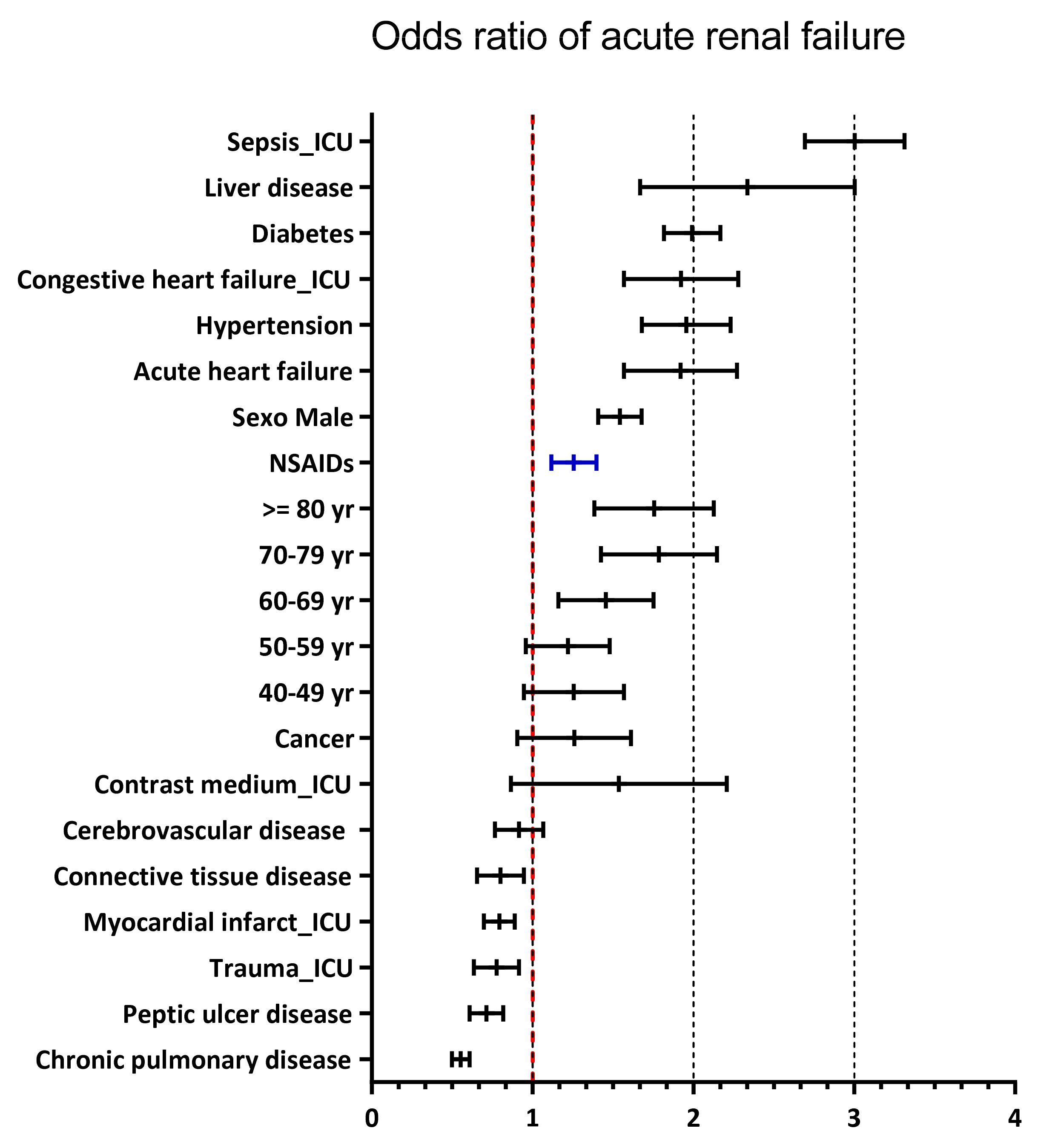Acute Kidney Injury in a Cohort of Critical Illness Patients Exposed to Non-Steroidal Anti-Inflammatory Drugs
Abstract
1. Introduction
2. Results
2.1. Association between NSAIDs, AKI, and Residual Confounding
2.2. Effect of NSAIDs on Presenting AKI
2.3. 28-Day Mortality of AKI and RRT Patients
3. Discussion
Variables Associated with NSAID Use
4. Materials and Methods
4.1. Type of Study and Sources of Information
4.2. Population
4.3. Study Variables
4.4. Statistical Analysis
5. Conclusions
Supplementary Materials
Author Contributions
Funding
Institutional Review Board Statement
Informed Consent Statement
Data Availability Statement
Conflicts of Interest
References
- Buffum, M.; Buffum, J.C. Nonsteroidal anti-inflammatory drugs in the elderly. Pain Manag. Nurs. 2000, 1, 40–50. [Google Scholar] [CrossRef]
- Larkai, E.N.; Smith, J.L.; Lidsky, M.D.; Graham, D.Y. Gastroduodenal mucosa and dyspeptic symptoms in arthritic patients during chronic nonsteroidal anti-inflammatory drug use. Am. J. Gastroenterol. 1987, 82, 1153–1158. [Google Scholar]
- Lockard, O.O., Jr.; Ivey, K.J.; Butt, J.H.; Silvoso, G.R.; Sisk, C.; Holt, S. The prevalence of duodenal lesions in patients with rheumatic diseases on chronic aspirin therapy. Gastrointest. Endosc. 1980, 26, 5–7. [Google Scholar] [CrossRef]
- Day, R.O.; Graham, G.G. Non-steroidal anti-inflammatory drugs (NSAIDs). BMJ 2013, 346, f3195. [Google Scholar] [CrossRef] [PubMed]
- Abraham, P.A.; Keane, W.F. Glomerular and interstitial disease induced by nonsteroidal anti-inflammatory drugs. Am. J. Nephrol 1984, 4, 1–6. [Google Scholar] [CrossRef] [PubMed]
- Nath, K.A.; Chmielewski, D.H.; Hostetter, T.H. Regulatory role of prostanoids in glomerular microcirculation of remnant nephrons. Am. J. Physiol. 1987, 252 Pt 2, F829–F837. [Google Scholar] [CrossRef]
- Griffin, M.R.; Yared, A.; Ray, W.A. Nonsteroidal antiinflammatory drugs and acute renal failure in elderly persons. Am. J. Epidemiol. 2000, 151, 488–496. [Google Scholar] [CrossRef] [PubMed]
- Vanmassenhove, J.; Lameire, N.; Dhondt, A.; Vanholder, R.; Van Biesen, W. Prognostic robustness of serum creatinine based AKI definitions in patients with sepsis: A prospective cohort study. BMC Nephrol. 2015, 16, 112. [Google Scholar] [CrossRef]
- Marsico, F.; Paolillo, S.; Filardi, P.P. NSAIDs and cardiovascular risk. J. Cardiovasc. Med. 2017, 18 (Suppl. S1), e40–e43. [Google Scholar] [CrossRef] [PubMed]
- Fosbol, E.L.; Folke, F.; Jacobsen, S.; Rasmussen, J.N.; Sorensen, R.; Schramm, T.K.; Andersen, S.S.; Rasmussen, S.; Poulsen, H.E.; Kober, L.; et al. Cause-specific cardiovascular risk associated with nonsteroidal antiinflammatory drugs among healthy individuals. Circ. Cardiovasc. Qual. Outcomes 2010, 3, 395–405. [Google Scholar] [CrossRef]
- Campbell, C.L.; Moliterno, D.J. Potential hazards of adding nonsteroidal anti-inflammatory drugs to antithrombotic therapy after myocardial infarction: Time for more than a gut check. JAMA 2015, 313, 801–802. [Google Scholar] [CrossRef] [PubMed]
- Rayego-Mateos, S.; Morgado-Pascual, J.L.; Opazo-Rios, L.; Guerrero-Hue, M.; Garcia-Caballero, C.; Vazquez-Carballo, C.; Mas, S.; Sanz, A.B.; Herencia, C.; Mezzano, S.; et al. Pathogenic Pathways and Therapeutic Approaches Targeting Inflammation in Diabetic Nephropathy. Int. J. Mol. Sci. 2020, 21, 3798. [Google Scholar] [CrossRef] [PubMed]
- Lai, K.M.; Chen, T.L.; Chang, C.C.; Chen, H.H.; Lee, Y.W. Association between NSAID use and mortality risk in patients with end-stage renal disease: A population-based cohort study. Clin. Epidemiol. 2019, 11, 429–441. [Google Scholar] [CrossRef] [PubMed]
- Sriperumbuduri, S.; Hiremath, S. The case for cautious consumption: NSAIDs in chronic kidney disease. Curr. Opin. Nephrol. Hypertens 2019, 28, 163–170. [Google Scholar] [CrossRef]
- Luo, X.; Jiang, L.; Du, B.; Wen, Y.; Wang, M.; Xi, X.; The Beijing Acute Kidney Injury Trial (BAKIT) Workgroup. A comparison of different diagnostic criteria of acute kidney injury in critically ill patients. Crit. Care 2014, 18, R144. [Google Scholar] [CrossRef]
- Singh, T.B.; Rathore, S.S.; Choudhury, T.A.; Shukla, V.K.; Singh, D.K.; Prakash, J. Hospital-acquired acute kidney injury in medical, surgical, and intensive care unit: A comparative study. Indian J. Nephrol. 2013, 23, 24–29. [Google Scholar] [CrossRef]
- Sigurdsson, M.I.; Vesteinsdottir, I.O.; Sigvaldason, K.; Helgadottir, S.; Indridason, O.S.; Sigurdsson, G.H. Acute kidney injury in intensive care units according to RIFLE classification: A population-based study. Acta Anaesthesiol. Scand. 2012, 56, 1291–1297. [Google Scholar] [CrossRef]
- Austin, P.C. An Introduction to Propensity Score Methods for Reducing the Effects of Confounding in Observational Studies. Multivar. Behav. Res. 2011, 46, 399–424. [Google Scholar] [CrossRef]
- Hernán, M.A.; Robins, J.M. Estimating causal effects from epidemiological data. J. Epidemiol. Community Health 2006, 60, 578–586. [Google Scholar] [CrossRef]
- Hammond, D.A.; Smith, M.N.; Painter, J.T.; Meena, N.K.; Lusardi, K. Comparative Incidence of Acute Kidney Injury in Critically Ill Patients Receiving Vancomycin with Concomitant Piperacillin-Tazobactam or Cefepime: A Retrospective Cohort Study. Pharmacotherapy 2016, 36, 463–471. [Google Scholar] [CrossRef]
- Rubin, D.B.; Thomas, N. Matching using estimated propensity scores: Relating theory to practice. Biometrics 1996, 52, 249–264. [Google Scholar] [CrossRef] [PubMed]
- Sandler, D.P.; Burr, F.R.; Weinberg, C.R. Nonsteroidal anti-inflammatory drugs and the risk for chronic renal disease. Ann. Intern. Med. 1991, 115, 165–172. [Google Scholar] [CrossRef] [PubMed]
- Lefebvre, C.; Hindie, J.; Zappitelli, M.; Platt, R.W.; Filion, K.B. Non-steroidal anti-inflammatory drugs in chronic kidney disease: A systematic review of prescription practices and use in primary care. Clin. Kidney J. 2020, 13, 63–71. [Google Scholar] [CrossRef] [PubMed]
- Folkestad, T.; Brurberg, K.G.; Nordhuus, K.M.; Tveiten, C.K.; Guttormsen, A.B.; Os, I.; Beitland, S. Acute kidney injury in burn patients admitted to the intensive care unit: A systematic review and meta-analysis. Crit. Care 2020, 24, 2. [Google Scholar] [CrossRef] [PubMed]
- Breslow, M.J.; Badawi, O. Severity scoring in the critically ill: Part 1—interpretation and accuracy of outcome prediction scoring systems. Chest 2012, 141, 245–252. [Google Scholar] [CrossRef] [PubMed]
- Breslow, M.J.; Badawi, O. Severity scoring in the critically ill: Part 2: Maximizing value from outcome prediction scoring systems. Chest 2012, 141, 518–527. [Google Scholar] [CrossRef]
- Oliveros, H.; Buitrago, G. Validation and adaptation of the Charlson Comorbidity Index using administrative data from the Colombian health system: Retrospective cohort study. BMJ Open 2022, 12, e054058. [Google Scholar] [CrossRef]
- Lipsitch, M.; Tchetgen Tchetgen, E.; Cohen, T. Negative controls: A tool for detecting confounding and bias in observational studies. Epidemiology 2010, 21, 383–388. [Google Scholar] [CrossRef]
- Shi, X.; Miao, W.; Tchetgen, E.T. A Selective Review of Negative Control Methods in Epidemiology. Curr. Epidemiol. Rep. 2020, 7, 190–202. [Google Scholar] [CrossRef]
- Lousdal, M.L.; Lash, T.L.; Flanders, W.D.; Brookhart, M.A.; Kristiansen, I.S.; Kalager, M.; Stovring, H. Negative controls to detect uncontrolled confounding in observational studies of mammographic screening comparing participants and non-participants. Int. J. Epidemiol. 2020, 49, 1032–1042. [Google Scholar] [CrossRef]
- Austin, P.C. Balance diagnostics for comparing the distribution of baseline covariates between treatment groups in propensity-score matched samples. Stat. Med. 2009, 28, 3083–3107. [Google Scholar] [CrossRef] [PubMed]



| Exposure Status | ||||
|---|---|---|---|---|
| Characteristic No. (%) | Full Sample | NSAID | Not NSAID | Standardized Differences % |
| n = 96,235 (100) | n = 16,068 (16.70) | n = 80,167 (83.30) | ||
| Median age (IQR)—year | 65 (53–76) | 61 (47–73) | 66 (54–76) | −25 |
| Age group—no. (%) | ||||
| 18–39 yr. | 11,770 (12.23) | 2924 (18.20) | 8846 (11.03) | 20 |
| 40–49 yr. | 7702 (8.0) | 1546 (9.62) | 6156 (7.68) | 6.9 |
| 50–59 yr. | 16,011 (16.64) | 2850 (17.74) | 13,161 (16.42) | 3.5 |
| 60–69 yr. | 23,193 (24.10) | 3597 (22.39) | 19,596 (24.44) | −4.9 |
| 70–79 yr. | 21,631 (22.48) | 3052 (18.99) | 18,579 (17.25) | −10.3 |
| ≥80 yr. | 15,928 (16.55) | 2099 (13.06) | 13.829 (17.25) | −11.7 |
| Sex—no. (%) | ||||
| Male | 46,604 (48.43) | 6905 (42.97) | 39,699 (49.52) | −13.2 |
| Female | 46,631 (51.57) | 9163 (57.03) | 40,468 (50.48) | |
| ICU admission | ||||
| Trauma | 6536 (6.79) | 1382 (8.60) | 5154 (6.43) | 8.2 |
| Sepsis | 8739 (9.08) | 1894 (11.79) | 6845 (8.54) | 10.8 |
| Myocardial infarction | 13,778 (14.32) | 2037 (12.68) | 11,741 (14.65) | −5.7 |
| Congestive heart failure | 2664 (2.77) | 392 (2.44) | 2272 (2.83) | −2.5 |
| Contrast medium | 590 (0.61) | 140 (0.87) | 450 (0.56) | 3.7 |
| Coexisting conditions—no. (%) | ||||
| Hypertension | 71,232 (74.02) | 11,347 (70.62) | 59,885 (74.70) | −9.2 |
| Diabetes | 30,478 (31.67) | 4.699 (29.24) | 25,779 (32.16) | −6.3 |
| Cerebrovascular disease | 6314 (6.56) | 1181 (7.35) | 5133 (6.40) | 3.7 |
| Chronic pulmonary disease | 26,490 (27.53) | 3581 (22.29) | 22,909 (28.58) | −14.5 |
| Connective tissue disease | 7056 (7.33) | 1211 (7.54) | 5845 (7.29) | 0.9 |
| Peptic ulcer disease | 10,901 (11.33) | 1823 (11.35) | 9078 (11.32) | 0.1 |
| Liver disease | 968 (1.01) | 155 (0.96) | 813 (1.01) | −0.5 |
| Cancer | 2011 (2.09) | 475 (2.96) | 1536 (1.92) | 6.8 |
| Outcomes in ICU | ||||
| Acute kidney injury | 21,233 (2.32) | 435 (2.71) | 1798 (2.24) | 3.0 |
| Pneumonia | 3.836 (3.99) | 775 (4.82) | 3.061 (3.82) | 4.9 |
| 28-day mortality | 11,858 (12.32) | 2289 (14.25) | 9569 (11.94) | |
| Variable | Exposed to NSAIDs n = 16,068 | Not Exposed to NSAIDs n = 80,167 | Standardized Differences | p Value |
|---|---|---|---|---|
| Age group—no. (%) | ||||
| 18–39 yr. | 18.2 | 18.2 | 0.1 | 0.965 |
| 40–49 yr. | 9.6 | 9.7 | −0.4 | 0.706 |
| 50–59 yr. | 17.7 | 17.6 | 0.2 | 0.884 |
| 60–69 yr. | 22.3 | 22.4 | −0.1 | 0.904 |
| 70–79 yr. | 18.9 | 18.9 | 0.1 | 0.932 |
| ≥80 yr. | 13.1 | 12.9 | 0.2 | 0.868 |
| Sex—no. (%) | ||||
| Male | 43 | 43 | 0.8 | 0.955 |
| ICU admission | ||||
| Trauma | 8.6 | 8.5 | 0.3 | 0.826 |
| Sepsis | 11.7 | 11.8 | −0.1 | 0.904 |
| Myocardial infarction | 12.6 | 12.4 | 0.8 | 0.479 |
| Congestive heart failure | 2.4 | 2.3 | 0.4 | 0.688 |
| Contrast medium | 0.8 | 0.8 | 0.8 | 0.501 |
| Coexisting conditions—no. (%) | ||||
| Hypertension | 70.6 | 70.7 | −0.3 | 0.825 |
| Diabetes | 29.2 | 29.1 | 0.2 | 0.825 |
| Cerebrovascular disease | 7.4 | 7.3 | 0.1 | 0.949 |
| Chronic pulmonary disease | 22.2 | 22.1 | 0.4 | 0.717 |
| Connective tissue disease | 7.5 | 7.4 | 0.4 | 0.751 |
| Peptic ulcer disease | 11.34 | 11.2 | 0.4 | 0.751 |
| Liver disease | 0.9 | 0.7 | 1.9 | 0.061 |
| Cancer | 2.9 | 2.7 | 1.1 | 0.385 |
| Outcomes | OR (95% CI) Unadjusted | OR (95% CI) Adjusted * | OR (95% CI) IPW ** |
|---|---|---|---|
| AKI with RTT | 1.21 (1.09–1.34) | 1.25 (1.12–1.39) | 1.28 (1.15–1.43) |
| Pneumonia | 1.28 (1.18–1.38) | 1.10 (1.00–1.21) | 1.07 (0.98–1.17) |
Publisher’s Note: MDPI stays neutral with regard to jurisdictional claims in published maps and institutional affiliations. |
© 2022 by the authors. Licensee MDPI, Basel, Switzerland. This article is an open access article distributed under the terms and conditions of the Creative Commons Attribution (CC BY) license (https://creativecommons.org/licenses/by/4.0/).
Share and Cite
Oliveros, H.; Buitrago, G. Acute Kidney Injury in a Cohort of Critical Illness Patients Exposed to Non-Steroidal Anti-Inflammatory Drugs. Pharmaceuticals 2022, 15, 1409. https://doi.org/10.3390/ph15111409
Oliveros H, Buitrago G. Acute Kidney Injury in a Cohort of Critical Illness Patients Exposed to Non-Steroidal Anti-Inflammatory Drugs. Pharmaceuticals. 2022; 15(11):1409. https://doi.org/10.3390/ph15111409
Chicago/Turabian StyleOliveros, Henry, and Giancarlo Buitrago. 2022. "Acute Kidney Injury in a Cohort of Critical Illness Patients Exposed to Non-Steroidal Anti-Inflammatory Drugs" Pharmaceuticals 15, no. 11: 1409. https://doi.org/10.3390/ph15111409
APA StyleOliveros, H., & Buitrago, G. (2022). Acute Kidney Injury in a Cohort of Critical Illness Patients Exposed to Non-Steroidal Anti-Inflammatory Drugs. Pharmaceuticals, 15(11), 1409. https://doi.org/10.3390/ph15111409








